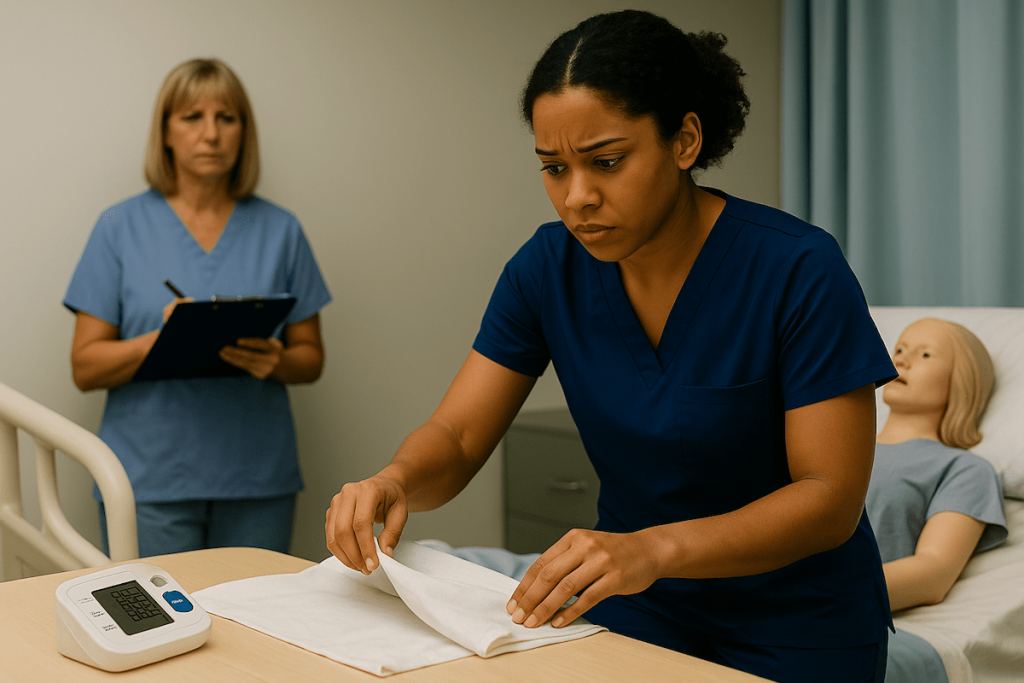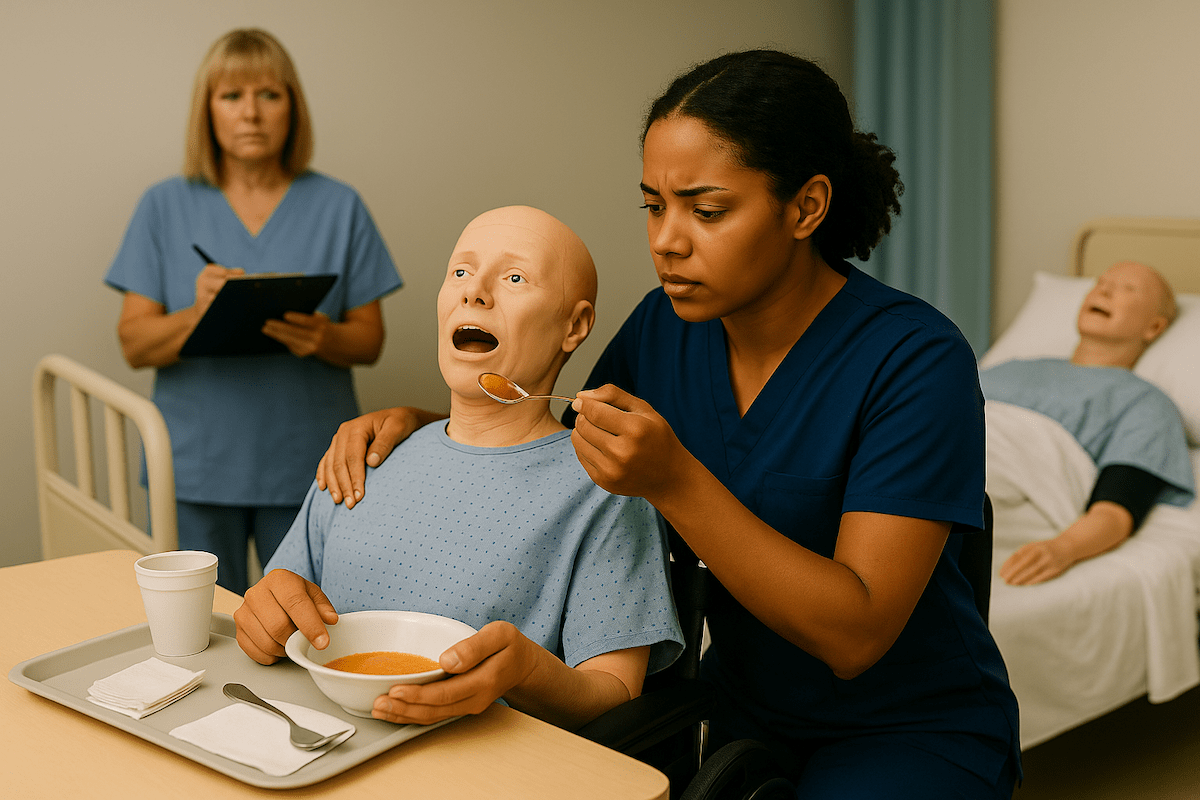
If you’re feeling anxious about performing female perineal care during your CNA skills test, that response makes complete sense. This intimate procedure requires precision under the evaluator’s observation. However, understanding that proper technique prevents 41% of nursing home UTIs can transform your perspective from an uncomfortable task to a life-saving healthcare skill.
Students often wonder why this particular skill receives such scrutiny during testing. The answer lies in infection prevention – E. coli from fecal contamination causes most nursing home UTIs, making proper perineal care a critical safety measure rather than just a routine task.
What CNAs Need to Know About Female Perineal Care Requirements
Female perineal care stands as one of the most medically significant skills in your CNA testing repertoire. Recent infection control studies show that 2.6% of long-term care residents develop UTIs, with many cases directly preventable through proper hygiene techniques.
Testing Environment Reality
Testing providers require hands-on demonstration with real supplies, not simulation. One CNA community member shared: “We actually had to do everything and use real supplies. The only thing we were allowed to verbalize was handwashing.”
This reality means students must master both technical precision and professional composure under direct observation. The medical necessity extends beyond testing requirements – healthcare facilities depend on CNAs to provide this intimate care with dignity and infection control expertise.
Professional Framework for Intimate Care
Understanding that your technique directly prevents painful infections and skin breakdown helps frame this as an essential medical intervention rather than an uncomfortable procedure. Professional boundaries naturally emerge through proper technique and communication, approaching intimate care with the same clinical objectivity used for any medical procedure.
Master This Skill With Expert Video Guides
Join 6,000,000+ students who passed with Mometrix’s proven study system
Get Instant Access →Step-by-Step Female Perineal Care Technique for CNA Testing
Mastering this technique requires understanding both the actions and the infection control reasoning behind each step. pH-balanced cleansers prevent the 11% skin breakdown rate associated with harsh soaps, making product selection critical for testing success.
- Gather Supplies and Check Water Temperature
Collect warm water, pH-balanced perineal cleanser, washcloths, towels, a clean underpad, and gloves.
Testing Tip: Water should feel comfortably warm to your wrist – evaluators watch for temperature safety.
Why This Matters: Proper preparation prevents mid-procedure delays that can cost points and demonstrates professional organization. - Provide Privacy and Explain Procedure
Close doors, pull curtains completely, and explain each step to your patient before beginning.
Testing Tip: Verbalize your privacy actions clearly so evaluators can confirm this step.
Why This Matters: Dignity preservation is a scored element across all testing providers. - Position Patient and Place Protective Pad
Help position the patient supine with knees bent, and place a clean underpad beneath the buttocks.
Testing Tip: Position the pad before donning gloves to avoid contamination issues.
Why This Matters: Proper positioning ensures access while maintaining patient comfort and bed protection. - Don Gloves and Remove Soiled Materials
Put on clean gloves, then carefully remove soiled incontinence products rolling inward.
Testing Tip: Never touch soiled materials without gloves – this is an automatic failure point.
Why This Matters: Infection control begins with proper barrier use before any patient contact. - Clean Front Perineal Area Front-to-Back
Apply cleanser to a washcloth, separate the labia gently, clean each side, then the center using front-to-back strokes.
Testing Tip: Use a clean cloth section for each stroke – reusing soiled areas causes automatic failure.
Why This Matters: The front-to-back technique prevents the fecal-urethral contamination pathway, causing most UTIs. - Rinse Thoroughly Front-to-Back
Use a clean, damp washcloth to remove all cleansers following the same front-to-back pattern.
Testing Tip: Incomplete rinsing is a common deduction – ensure all soap residue is removed.
Why This Matters: Soap residue causes skin irritation and breakdown in incontinent patients. - Clean the Anal Area from Front to Back
Turn patient to side, clean from vaginal area toward rectum using fresh washcloth sections.
Testing Tip: Never allow contaminated cloth to contact front areas after cleaning the back.
Why This Matters: This phase prevents the contamination that causes 41% of nursing home UTIs. - Final Rinse and Dry
Rinse anal area completely, then pat entire perineal area dry using front-to-back motions.
Testing Tip: Patting rather than wiping prevents skin trauma and shows gentle technique.
Why This Matters: Thorough drying prevents moisture-related skin breakdown and fungal infections. - Apply Barrier Protection and Reposition
Apply barrier cream if ordered, position a fresh underpad, and help the patient to a comfortable position.
Testing Tip: Check care plan for barrier cream orders – omitting prescribed treatments loses points.
Why This Matters: Skin protection prevents the dermatitis that leads to pressure ulcers. - Complete Safety and Hygiene Protocol
Remove gloves properly, perform hand hygiene, ensure the call light is within reach, and lower the bed.
Testing Tip: The Bed must be in the lowest position before signaling completion.
Why This Matters: Safety protocols prevent falls and maintain infection control standards.
Practice With 600+ CNA Exam Questions
See exactly how this skill appears on the real test
Interactive Female Perineal Care Skills Checklist
Practice makes perfect, especially when evaluators are watching your every move. Our interactive female perineal care checklist lets you track each critical step while building the muscle memory that leads to confident testing performance.
This comprehensive checklist covers all provider-specific requirements from NNAAP, Prometric, and Headmaster protocols. Use it during practice sessions to ensure you hit every evaluation point that testing providers assess.
Download the printable PDF version to take to clinical practice or study sessions. The checklist format mirrors actual testing evaluation forms, helping you think like an evaluator while perfecting your technique.
Managing Performance Anxiety During Intimate Care Procedures
The psychological challenge of performing intimate care under observation is real and normal. This experience resonates throughout CNA communities: “Getting nervous when evaluators watch closely affects performance even when students know the procedures well.”
Breathing and Mental Preparation Strategies
Focus on your breathing before entering the testing room. Deep, controlled breaths activate your parasympathetic nervous system, reducing the fight-or-flight response that can cause trembling hands or racing thoughts.
Reframe the evaluator as a healthcare colleague rather than a judge. They want to see competent, compassionate care and are there to verify your ability to provide safe patient care.
Professional Communication Scripts
Many students find that practicing specific phrases builds confidence. Working CNAs emphasize communication: “Always tell your patient exactly what you are going to do before you do it.”
Use phrases like: “I’m going to help you with your personal care now to keep you clean and comfortable” or “I’ll be as gentle as possible while making sure you’re thoroughly clean.”
Connecting Technique to Patient Safety
Many CNAs report that connecting each step to patient safety helped them move past their initial discomfort with intimate procedures. Understanding that proper technique prevents painful infections transforms the procedure from an embarrassing task to essential medical care.
Remember that experienced healthcare professionals perform these procedures thousands of times throughout their careers. Your competence in intimate care demonstrates your readiness for professional nursing practice.
Common Perineal Care Mistakes That Cause CNA Test Failures
Understanding failure points helps students avoid critical errors that cause automatic test failure. Improper wiping direction is the #1 observed testing error across all providers, making technique precision essential.
Critical Failures (Automatic Test Failure)
Wrong Wiping Direction: Back-to-front wiping introduces fecal bacteria to the urethral area
- Prevention: Always start from the urethral area and wipe toward the rectum
- Testing Reality: This error causes immediate failure across all testing providers
Cross-Contamination: Using the same cloth section for multiple areas
- Prevention: Use a clean cloth section for each stroke, never reuse soiled areas
- Testing Reality: Evaluators specifically watch for this infection control breach
No Gloves or Improper Glove Use: Touching the patient without barrier protection
- Prevention: Don gloves before any patient contact, change if contaminated
- Testing Reality: Infection control violations result in automatic failure
Major Deductions (Significant Point Loss)
Incomplete Rinsing: Leaving soap residue on skin
- Prevention: Use a second washcloth to remove all cleanser thoroughly
- Testing Impact: Common oversight that costs multiple points
Forgetting Anal Area Cleaning: Only cleaning the front perineal area
- Prevention: Remember, this is complete perineal care, not just genital cleaning
- Testing Impact: Incomplete care results in unsatisfactory skill performance
Improper Positioning: Not providing privacy or leaving the patient exposed
- Prevention: Close curtains completely and maintain appropriate draping
- Testing Impact: Dignity violations are heavily penalized
Provider-Specific Mistakes
Students consistently find that understanding provider differences prevents confusion during testing. This confusion appears frequently in student discussions: “I was told you use regular body soap for peri care… The exam manual says perineal/pH-balanced soap.”
CRITICAL TESTING INSIGHT: Wrong wiping direction (back-to-front) is the #1 cause of automatic failure across all testing providers. Always start from the urethral area and wipe toward the rectum.
Testing Provider Requirements: NNAAP vs. Prometric vs. Headmaster
Each testing provider has specific requirements that can affect your performance. Understanding these differences ensures you prepare for your actual testing environment rather than generic procedures.
| Critical Difference | NNAAP | Prometric | Headmaster |
| Water Temperature | Must verify comfort with the patient | Check safety, comfort implied | Check the safety temperature |
| Glove Changes | No mid-procedure change required | No mid-procedure change required | Must change gloves between front/back |
| Underpad Management | Place a clean pad, removal implied | Must explicitly remove the soiled pad first | Remove after completing back care |
| Safety Protocols | Basic bed/call light requirements | Emphasizes ongoing safety checks | Must raise the bed and secure the side rails |
NNAAP-Specific Requirements
Testing providers notice that candidates who understand the reasoning behind each step demonstrate more confident technique. NNAAP emphasizes patient communication and comfort verification throughout the procedure.
Key checkpoints include water temperature verification with the patient and maintaining clean technique without mid-procedure glove changes. The front-to-back cleaning requirement applies to both genital and rectal areas with clean cloth sections for each stroke.
Prometric Protocol Emphasis
Prometric evaluators specifically watch for the soiled pad replacement before cleaning begins. This step often trips up students who learned generic procedures without provider-specific details.
The checkpoint system evaluates both direct care skills and indirect care behaviors like communication, safety awareness, and infection control throughout the procedure.
Headmaster Unique Requirements
Headmaster’s mid-procedure glove change requirement sets it apart from other testing providers. Students must remove gloves after front cleaning, perform hand hygiene, then don fresh gloves for anal area care.
The bed elevation and side rail protocols demonstrate safety awareness that evaluators specifically assess. Understanding why we do each step helped students feel more confident during testing.
Female Perineal Care Video Demonstrations
Watch our step-by-step video demonstrations showing proper female perineal care technique for each primary testing provider. These videos bridge the gap between written instructions and hands-on performance, helping you visualize the subtle differences that can impact your test results.
Female Perineal Care FAQ for CNA Students
How do you clean the female perineal area for a CNA test?
Clean from front to back using a pH-balanced cleanser. Separate the labia for thorough access. Use clean washcloth sections for each stroke. Rinse completely. Maintain patient dignity throughout.
What direction do you wipe during female perineal care?
Always wipe front to back (urethra toward anus) to prevent fecal bacteria from contaminating the urinary tract. This prevents UTI-causing organisms from entering sterile areas.
Do you change gloves during the perineal care CNA test?
Provider-specific: Headmaster requires a glove change between front and back cleaning with hand hygiene. NNAAP and Prometric allow continuous glove use throughout the procedure.
What cleaning products are used for female perineal care?
Use pH-balanced perineal cleansers rather than harsh soaps. These products maintain skin integrity while providing effective cleaning without causing skin breakdown.
Why is front-to-back wiping important for CNAs?
The front-to-back technique prevents the contamination pathway that causes 41% of nursing home UTIs. Proper direction keeps fecal bacteria away from the urethral opening.
How long does perineal care take on the CNA exam?
Most testing providers allow 5-10 minutes for complete perineal care, including setup, cleaning, and documentation.
Ready to Ace Your CNA Exam?
Get everything you need: video guides, practice tests, and detailed study plans





